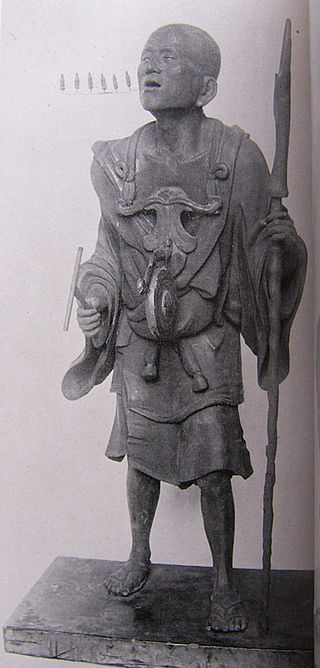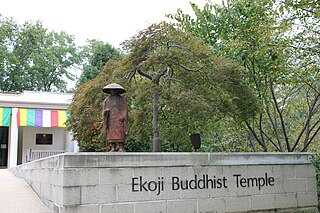Related Research Articles

Shinran was a Japanese Buddhist monk, who was born in Hino at the turbulent close of the Heian Period and lived during the Kamakura Period. Shinran was a pupil of Hōnen and the founder of what ultimately became the Jōdo Shinshū sect of Japanese Buddhism.

Jōdo Shinshū, also known as Shin Buddhism or True Pure Land Buddhism, is a school of Pure Land Buddhism. It was founded by the former Tendai Japanese monk Shinran.

Nianfo in Chinese, or Nembutsu (Japanese) is a term commonly seen in Pure Land Buddhism. In the context of Pure Land practice, it generally refers to the repetition of the name of Amitābha. It is a translation of Sanskrit buddhānusmṛti.

Rennyo was the 8th Monshu of the Hongan-ji Temple of the Jōdo Shinshū sect of Buddhism, and descendant of founder Shinran. Jodo Shinshu Buddhists often referred to as the restorer of the sect. He was also known as Shinshō-in (信証院), and posthumously Etō Daishi (慧灯大師). During the conflict of the Ōnin War and the subsequent warfare that spread throughout Japan, Rennyo was able to unite most of the disparate factions of the Jodo Shinshu sect under the Hongan-ji, reform existing liturgy and practices, and broaden support among different classes of society. Through Rennyo's efforts, Jodo Shinshu grew to become the largest, most influential Buddhist sect in Japan.

Jōdo-shū, also known as Jōdo Buddhism, is a branch of Pure Land Buddhism derived from the teachings of the Japanese ex-Tendai monk Hōnen. It was established in 1175 and is the most widely practiced branch of Buddhism in Japan, along with Jōdo Shinshū. In the general classification of Buddhism in Japan, the Jōdo-shū, the Jōdo Shinshu, the Ji-shu and the Yuzu Nembutsu shu are collectively classified into the lineage of Jōdo Buddhism.

With nearly 250,000 Buddhists, Brazil is home to the third-largest Buddhist population in the Americas, after the United States and Canada. Buddhism in Brazil consists of practitioners from various Buddhist traditions and schools. A number of Buddhist organisations and groups are also active in Brazil, with nearly 150 temples spread across the states.

Hongan-ji, also archaically romanized as Hongwanji, is the collective name of the largest school of Jōdo Shinshū Buddhism. 'Hongan-ji' may also refer to any one of several actual temple buildings associated with the sect. Nishi Honganji (西本願寺) and Higashi Honganji (東本願寺) are two major temples in Kyoto.
The Buddhist Churches of America is the United States branch of the Nishi Honganji subsect of Jōdo Shinshū Buddhism.
In Shin Buddhism, Shinjin (信心) was originally the Japanese word for the Buddhist concept of citta-prasāda, but now carries a more popular related meaning of faith or entrusting. According to Ueda, "shinjin is the mind of Amida Buddha given to and realized in a person. Shinran interprets shin (信) to mean truth, reality, sincerity; jin (心) means mind. When shinjin is realized, Amida's mind and the practitioners mind of blind passions become one."

Nishi Hongan-ji (西本願寺) is a Jōdo Shinshū Buddhist temple in the Shimogyō ward of Kyoto, Japan. It serves as the head temple of the sub-sect Honganji-ha.
The Buddhist Women's Association (BWA) is the English name of the worldwide auxiliary lay organization of the Nishi Hongwanji-ha branch of Jodo Shinshu Buddhism. Its Japanese name is Fujinkai. Many Jodo Shinshu temples in Japan, mainland United States, Hawaii, South America, and Canada have BWA chapters. The honorary head of the worldwide BWA is, traditionally, always the spouse (o-urakata) of the current Nishi Hongwnaji-ha monshu ; at this time, this position is held by the Lady Noriko Ohtani.

Ekoji is a temple of the Jōdo Shinshū Hongwanji-ha Japanese Buddhist sect in Fairfax Station, Virginia, near Washington, D.C. It is a member of the Buddhist Churches of America, the oldest Buddhist organization in the mainland United States.
Alfred Bloom was an American Shin Buddhism scholar, who pioneered Jōdo Shinshū studies in the English-speaking world.

The Institute of Buddhist Studies is a Jodo Shinshu-affiliated seminary and graduate school, located in Berkeley, California. It is a member school of the Graduate Theological Union, also located in Berkeley. Its mission is to provide graduate level education in the entirety of the Buddhist tradition with specialization in Jodo Shinshu ministry and Buddhist chaplains. It is the sole seminary for ministers serving temples in the United States through the Buddhist Churches of America, the U.S. mainland branch district of the Nishi Hongwanji sect of Japanese Buddhism.

Kenjōdo Shinjitsu Kyōgyōshō Monrui (顕浄土真実教行証文類), often abbreviated to Kyōgyōshinshō (教行信証), is the magnum opus of Shinran Shonin, the founder of the Japanese Buddhist sect, Jodo Shinshu. The title is often translated as The True Teaching, Practice, and Realization of the Pure Land Way in English. The work was written after Shinran's exile, and is believed to have been composed in the year 1224.

The Honpa Hongwanji Mission of Hawaii is a district of the Nishi (West) Hongwanji branch of Jodo Shinshu Buddhism, a school of Mahayana Pure Land Buddhism.

A kaisan-dō, also termed the Founder's Hall, is a temple structure in a Japanese Buddhist monastery complex or other temple where an image of the founding abbot and other significant teachers and Buddha ancestors are kept, along with a memorial slab. Sometimes also referred to as the Patriarch Hall (soshido) or Reflection Hall (Eishitsu), this building holds memorial services yearly on the anniversary of the death of the founding abbot.
The Jodo Shinshu Buddhist Temples of Canada are a group of temples and fellowships that are affiliated with the Nishi Hongan-ji of Kyoto, Japan, the mother temple of the Jodo Shinshu sect of Buddhism.

The Pacific Buddhist Academy is a private, co-educational college preparatory high school in Honolulu, Hawaii.

Ōtani-ha is a Japanese Buddhist movement. It belongs to Jōdo Shinshū, also known as Shin Buddhism. The movement has approximately 5.5 million members.
References
- ↑ "Japanese Buddhism: a Short History | Buddhist Studies". ibc.ac.th. Archived from the original on 2007-08-22.
- ↑ "Accueil".
- ↑ "Japanese Buddhism: A Short History". Archived from the original on 2010-01-24. Retrieved 2010-01-24.